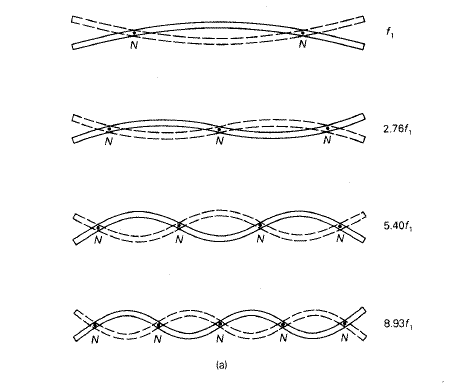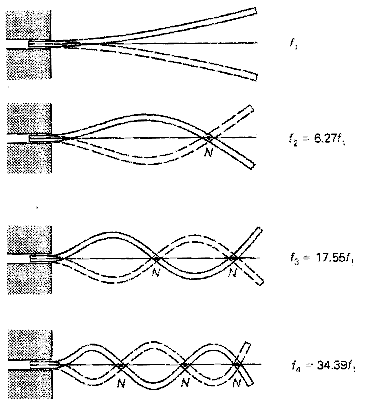Features of Percussion
- Transient Sounds
- Some clearly pitched, some roughly pitched, some unpitched
- Sound modified greatly by the choice of stick
- Sounds often modified by where the instrument is struck
Issues in Percussion
- What is needed to make a pitched sound?
- Very pitched like glockenspiel and gongs
- Somewhat pitched like various small drums, cymbals,
triangle
- Totally unpitched like rain stick.
- How does stick hardness alter the sound?
- Padded heads produce dull sounds, hard heads produce
bright sounds. Why?
- How do drum bodies affect the sound?
- Bass drums are very unpitched, kettle drums are quite
strongly pitched, heads very similar.
Families of Percussion
Membranophones
Instruments where the sound is produced by a skin stretched
over a frame or a resonator. Most drums fall into this family
(there exist stone drums too). There is a range of couplings between
body and membrane and a range of sound types:-
- Moderately pitched instruments such as the kettle drum where
the resonator plays a crucial role in shaping the sound and
the spectrum has a number of strong, nearly harmonic, partials
- Less tuned bongo and congo types where the resonator body
simply emphasises a range of pitches in a non-harmonic spectrum
so that there are clearly high and low sounds but no clear
notes
- Cylinder drums where the resonator is still less important
and only shapes the overall shape of the spectrum weakly.
These have no real sense of pitch but there are higher and
lower drums. These include the tenor drums of a pipe band,
the orchestral bass drum, and the side drums of a trap set.
- Snare drums add a noise maker to a standard cylinder drum
to make a sound which is almost pure noise. This has great
penetrating power but no sense of pitch at all.
The sounds of drums are strongly influenced by the way in which
they are played. Striking the drum towards the center reinforces
the lowest modes (those with the longest wavelength in the mebrane)
while striking towards the edge reinforces higher modes. Stricking
with a small or hard stick produces a sharper sound with much
more high frequency energy than striking with a large or soft
stick. The size of the stick influences the wavelength of drum
mode that is most strongly excited. The softness affects how
the stick damps the sound. Soft sticks stay in contact with
the drum skin longer, damping out higher frequency modes and
leading to a less bright sound than hard sticks. The same effect
is seen in the struck bar instruments as discussed more below.
Xylophones
Strictly any instrument whose sounding portion is made of wood
but commonly tuned bar instruments. These can be plain bars
as in the classic xylophone or can add resonators as in the
Mariba, the Xylorimba, and the Indonesian Gambang. The natural
modes of a struck bar ar not harmonic and the bars are shaped
and suspended so as to make the spectrum more harmonic.
Other wooden instruments include the tuned temple blocks and
untuned noise makers such as castanets, the whip, maracas, and
the funny ridged stick that you rub with another stick (the
rasp).
Metalophones
Instruments where the sounding portion is made of metal are
called metalophones. These range from strongly pitched instruments
such as the suspended vibraphone and glockenspiel, through the
moderately tuned orchestral chimes, bells, and gongs to the
very untuned cymbals and triangles. The strongly pitched ones
operate very similarly to the struck bar xylophones and are
further discussed below.
Lithophones
Instruments where the sounding portion is made of stone. While
rare in the west these are found in other parts of the world.
Pretty much any kind of instrument that you can make from wood
or metal can also be made from stone and the familes are the
same.
Suspended Bar Modes

- Modes of a uniform bar suspended freely are also strongly
non-harmonic.
- We can force them to be nearly harmonic in 2 ways
- Adjust the profile of the bar.
- Thinning the center of the bar reduces the stiffness
for the simple bending mode without strongly affecting
the other modes. This lowers the natural frequency of
the lowest mode and makes the lowest two frequencies more
nearly harmonic.
- Alter the way the bar is mounted.
- Sitting the bar on carefully placed dampers allows only
modes mode that have nodes near the suspension point to
survive. Modes that involve much motion of the suspensions
points are damped and decay away quickly.
Different mallets, different tones.
The tone quality of a struck bar instrument is strongly
affected by the choice of mallet.
By controlling the hardness and shape of the mallets the
player can exert a certain amount of control over the tone
quality of the instrument.
- Wide headed mallets can only excite longer wavelength
modes. Modes with wavelengths (in the bar) that are shorter
than the mallet head will be strongly damped. Wide mallets
provide purer, less overtone rich, sounds.
- Narrow headed mallets provided strongly peaked forces
and can excite high frequency, short wavelength modes
very easily. They provide a bright sound, rich in upper
partials.
- Mallets made from soft materials stay in contact with
the bar for a significant length of time. Normal modes
with periods that are shorter than the contact time will
be damped as the mallet stays on the bar.
- Mallets made from hard materials stay in contact with
the bar only a very short length of time. They can excite
the highest frequency modes.
Clamped Bar Modes

- Do because we can demo not because they are particularly
musically important
- Iannis Xenakis invented an instrument called the Sixxen
that uses clamped plates struck with mallets. Because
the sound is non-harmonic the pitch of each note is not
perfectly clear but there are clearly higher and lower
notes .
- Heard in person these instruments are very loud! When
Les Percussions de Strasbourg came last year I measured
sound levels midway in Wellin Hall of over 100dB.
|